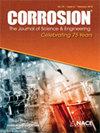The Role of Nickel in Low Alloy Steels exposed to H2S-containing environments. Part II: Effect of the Electrochemical Potential and Stress Level on Trench Formation
IF 1.3
4区 材料科学
Q4 MATERIALS SCIENCE, MULTIDISCIPLINARY
引用次数: 0
Abstract
ABSTRACT In the first part of this paper, trenches were reported for Ni-containing steels tested using the slow strain rate test method in H2S-containing environments at the open circuit potential. Trenches are deep elongated pits, and their appearance is more alike to small blunt cracks. These features can develop a sharp sulfide stress crack at their bottom under certain conditions, which are still not fully understood. In this second and final part, the effect of the electrochemical potential and the stress level in trench nucleation and growth was investigated for the same set of Ni-containing steels with up to 5 wt.% Ni. The anodic nature of the trench formation mechanism was verified, and under an anodic polarization a critical stress value for trench formation, σtrench, was estimated from slow strain rate tests and finite element modeling. Applying a cathodic potential suppressed trench formation, but not cracking, because cracks nucleated and propagated by hydrogen stress cracking (HSC). The resulting environmental and stress-level dependencies for Ni steels confirmed that trenches could be considered a form of environmental-assisted cracking. It is concluded that the main role of trenches is to provide favorable spots for hydrogen stress crack nucleation at OCP, but their presence is neither necessary nor sufficient for cracking occurrence.暴露于含硫化氢环境中的低合金钢中镍的作用。第二部分:电化学电位和应力水平对海沟形成的影响
在本文的第一部分中,用慢应变率试验方法对含镍钢在含h2s环境下的开路电位进行了沟槽试验。沟是深的细长的坑,其外观更像小的钝裂纹。这些特征在一定条件下会在其底部形成尖锐的硫化物应力裂纹,这一点至今仍未完全了解。在第二部分,也是最后一部分,研究了电化学电位和应力水平对同一组含镍钢槽形核和生长的影响,镍含量高达5 wt.%。验证了沟槽形成机理的阳极性质,并通过慢应变率试验和有限元模拟估计了在阳极极化条件下沟槽形成的临界应力值σ沟槽。施加阴极电位抑制了沟槽的形成,但没有抑制裂纹,因为裂纹是由氢应力裂纹(HSC)成核和扩展的。由此产生的镍钢的环境和应力水平依赖性证实,沟槽可以被认为是一种环境辅助开裂形式。结果表明,沟槽的主要作用是在OCP上为氢应力裂纹形核提供有利的位置,但沟槽的存在既不是裂缝发生的必要条件,也不是裂缝发生的充分条件。
本文章由计算机程序翻译,如有差异,请以英文原文为准。
求助全文
约1分钟内获得全文
求助全文
来源期刊

Corrosion
MATERIALS SCIENCE, MULTIDISCIPLINARY-METALLURGY & METALLURGICAL ENGINEERING
CiteScore
2.80
自引率
12.50%
发文量
97
审稿时长
3 months
期刊介绍:
CORROSION is the premier research journal featuring peer-reviewed technical articles from the world’s top researchers and provides a permanent record of progress in the science and technology of corrosion prevention and control. The scope of the journal includes the latest developments in areas of corrosion metallurgy, mechanisms, predictors, cracking (sulfide stress, stress corrosion, hydrogen-induced), passivation, and CO2 corrosion.
70+ years and over 7,100 peer-reviewed articles with advances in corrosion science and engineering have been published in CORROSION. The journal publishes seven article types – original articles, invited critical reviews, technical notes, corrosion communications fast-tracked for rapid publication, special research topic issues, research letters of yearly annual conference student poster sessions, and scientific investigations of field corrosion processes. CORROSION, the Journal of Science and Engineering, serves as an important communication platform for academics, researchers, technical libraries, and universities.
Articles considered for CORROSION should have significant permanent value and should accomplish at least one of the following objectives:
• Contribute awareness of corrosion phenomena,
• Advance understanding of fundamental process, and/or
• Further the knowledge of techniques and practices used to reduce corrosion.
 求助内容:
求助内容: 应助结果提醒方式:
应助结果提醒方式:


